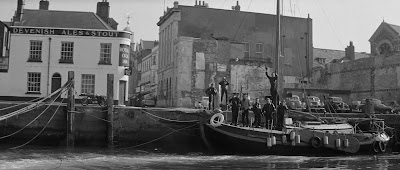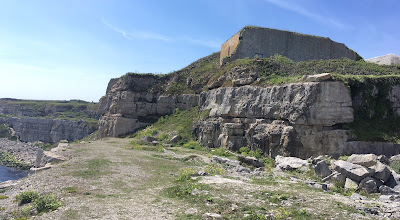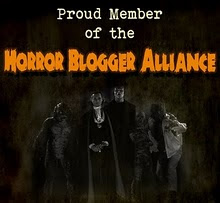“Just my luck. Some people meet with Ursula Andress or Brigitte Bardot in their dreams. I always meet with some crazy woman who thinks she’s Nostradamus…”
Also unleashed upon the Parisian public as ‘Perversiones Lubriques’, ‘Draguse ou Le Manoir Infernal’ is a horror-tinged French sex film directed by Patrice Rhomm, a filmmaker probably best known (relatively speaking) for contributing to the script for the thoroughly batzo Italio-Belgium trash classic ‘The Devil’s Nightmare’ (1972).
Armed with the knowledge, the opening ten minutes of ‘Draguse’ had me ready to declare Rhomm an unheralded pulp horror savant. Sadly, I fear things went a little awry as my viewing progressed, but… let’s kick off with the good stuff, shall we?
Enlivened by the strains of a delightfully spooky, propulsive library track, ‘Draguse’s opening credits give us skeletal trees under an overcast sky and brooding shots of one of those shabby / decrepit rural houses so believe of low budget French horror.
As a handheld camera proceeds to explore the house’s suitably rundown interior, silver-haired Eurocine mainstay Olivier Mathot begins to deliver a monologue in voiceover, explaining that he is being transported to this house in his dreams, wherein his spirit is imprisoned within a pentangle (nattily represented by a mirror with what looks like some cake icing daubed upon it) as he is forced to witness the lewd and perverse displays enacted for him by a witch named Draguse (Eurocine & Jess Franco regular Monica Swinn).
Soon, a flash of lightning turns the pink candles black (frankly neither colour is really suitable for the lighting needs of god-fearing citizens, I fear), a gnarly-looking skull and crossbones appears upon the frame of some kind of antique furnace-type thing, and Draguse baptises the skull with a trickle of deep red blood.
With these formalities out of the way, more rockin’ library music kicks in, as Swinn treats us to some lascivious dancing in a baby doll nightie, before spreading her legs across a nearby armchair and proceeding to pleasure herself (non-penetratively, I hasten to add) with a massive bone.
My god, what is this movie? It’s demented, and amazing. Total ‘70s witch-smut nirvana.
It is at this point however that Monsieur Mathot awakens with the standard issue “whaaa, where am I?!” comic flourish, and we discover that, like seemingly all people in ‘70s French movies, he actually lives in a cramped, high rise Parisian apartment with amazing wallpaper and flowery bed sheets, shared on this occasion with his perpetually naked and very much up-for-it wife (Martine Fléty, who also appeared in a number of Jess Franco films in the late ‘70s).
Much to Ms Fléty’s chagrin however, Mathot soon turns out to be essaying that most tedious of sex comedy clichés, the serious-minded, frigid academic who steadfastly ignores the parade of willing female flesh which is constantly paraded before him wherever he goes.
A historian by trade, Mathot’s character dreams of publishing his great historical monograph on The Queens of Scotland, but his publisher (played by director Rhomm) has other ideas - namely, inexplicably hiring this sexless stick in the mud to write a series of erotic novels for the paperback market.
Taking this new assignment rather more seriously than anyone presumably intended, Mathot declares that he will relocate to the countryside and rent the house seen during the opening, in order to gain the solitude he needs to compose his new literary masterworks. In a turn of events more far-fetched than any of the film’s supernatural elements, his publisher not only voices his approval for this idea, but even volunteers to cover the rent.
Before heading out to the sticks however, our hero begins his ‘research’ by conducting an in-depth survey of Paris’s adult entertainment industry - or, in other words, Rhomm’s camera goes on a lengthy, handheld ramble around the exteriors of various sex shops and porno cinemas, whilst Mathot contributes a witless, nattering voiceover over the top.
I’m assuming that the film’s original audience (who would have been more than familiar with such sights) must have found the inclusion of this time-killing filler material absolutely infuriating, but the passage of a few decades has ironically turned it into an absolute goldmine for 21st century smut historians, giving us a fleeting glimpse of all manner of funky, pop art-influenced décor and long-forgotten posters and cinema hoardings, not least some promo material for the Jess Franco sex comedy ‘Le Jouisseur’ (aka ‘Sexy Erotic Job’, aka ‘Roland, The Sexiest Man in the World’). So, count that as another point in ‘Draguse’s favour, if you are thus inclined.
When Mathot eventually arrives at his shabby rural hideaway (which, with typical porno logic, is still close enough to town for him to walk to the red light district to buy cigarettes), we might reasonably have expected the film’s horror quotient to pick up again, but sadly that’s not quite the way things pan out, despite a few spooky manifestations from the titular Draguse.
Instead, the movie veers off into a rather lackadaisical series of disconnected vignettes. First, Mathot picks up a prostitute (Sylvia Bourdon, who went on to appear the following year in the inserts shot by Jean Rollin for the bastardised porno version of his own ‘Lips of Blood’). Then, once that’s all over with, he dresses up like Count Yorga and visits a fun fair, somehow convincing an idle, hippy-ish bloke to return with him to the house to have sex with the (apparently now corporeal) Draguse, who subsequently kills him, leaving Mathot (who is apparently now dreaming this whole escapade) to dispose of the body.
After dawdling well past the half-way mark with this sort of thing, ‘Draguse..’ then makes a belated attempt to transform itself into a kind of Amicus-style anthology movie, as Swinn turns up in a second role, playing a sort of “real life” avatar of Draguse.
Ostensibly a secretary who has been dispatched by Mathot’s publisher to help him get his shit together, this lady begins telling him erotic / macabre tales ostensibly based on the house’s sordid history, each of which is dramatised as a stand-alone vignette featuring Mathot as the male protagonist.
So, first we enjoy the ‘tale’ (if it can indeed be termed as such) of a stuffy tutor trysting with a hotpants-clad nymphet (Danièle Nègre). Then, we bear witness to a Nazisploitation-themed light bondage threesome, in which a Hitler-fixated photographer (Mathot again) lures a model (Claudine Beccarie, who appeared in the original version of ‘Lips of Blood’) back to his lair for some jackbooted hi-jinks with a dominatrix (French porno regular Erika Cool).
I could make a point of noting that everyone present in this scene (plus Swinn to boot) reunited two years later for Eurocine’s epic disasterpiece ‘Train Spécial pour SS’ (aka ‘Special Train for Hitler’)… but to be honest, material like this was so ubiquitous in the lower depths of Western European exploitation cinema during this era that you’d almost be surprised if a film featuring Mathot and Swinn didn’t include somebody busting out the swastikas and riding crops at some point.
(A special mention should probably be made however of the fact that, once several Nazi marching songs have been aired on the gramophone, the reminder of the scene is soundtracked with what sounds like a recording of chugging train carriages. Tasteful.)
Anyway - by this point, any vestige of the witchy / horror aesthetic featured in ‘Draguse’s opening scenes is long gone, and sadly it never really returns. Towards the end of the film, there’s even a suggestion that the ‘real life’ Draguse (the secretary lady) may have been spiking Mathot’s drinks, causing him to hallucinate, thus conveniently nixing the film’s supernatural element altogether. (Given that secretary-Swinn doesn’t even turn up until two thirds of the way through the movie, this explanation …. well, hell, it makes about as much sense as anything else here I suppose…)
Whilst ‘Draguse’ is eventually a bit of a bust in terms of horror, it should be noted that it is equally unsatisfactory as a sex film, in spite of all the kinky shenanigans outlined above.
Attaining modest historical significance as the first domestic French production to be awarded the country’s ‘X’ certificate (meaning that it could be legally screened with unsimulated sex scenes), the film nonetheless continues to inhabit an uncomfortable no man’s land between ‘soft’ and ‘hard’ cores.
A few, fleeting moments of explicit ‘action’ are included, but the film still largely relies on simulated coupling, often confined to long shots and lacking the artful/imaginative approach which allowed directors like Franco to liven up such ‘hard soft’ material in this period. (And yes, I’m going for a record for “most references to Jess Franco in a non-Franco review” here - thanks for noticing.)
This problem is exacerbated by the fact that the middle-aged Mathot - who ostensibly takes part in every sex scene - did not ‘do’ hardcore, meaning that an obvious body double is employed for his sporadic full frontal / below the belt shots. Disastrously however, it appears that even Mathot’s allotted stunt-cock had trouble performing, lending the film’s sex scenes an awkward, fragmentary quality which somehow feels far more furtive and unsavoury than the, uh, ‘natural flow’, shall we say, of the full-on pornography which would come to dominate low budget French film production over the next few years.
Despite the fact that it conspicuously fails in pretty much everything it set out to achieve however, I must confess that - for some peculiar reason - I found ‘Draguse ou Le Manoir Infernal’ both exceptionally charming and hugely enjoyable.
I’m not sure I can quite explain why this is the case. Perhaps it was watching those Jean Rollin softcore movies all those years ago which warped my brain, or perhaps my recent enthusiasm for the films of Michel Lemoine has something to do with it [see my write-up on his ‘Les Désaxées’ here], but I just love the wonky, off-kilter, frankly ridiculous world in which these pre-hardcore French erotic films take place.
Even in a frankly shabby, low budget effort like this, it just all feels like so much fun; it’s all so inherently, casually surrealistic, full of bright, comic book-like colours and weird, canned music, interspersed with time-killing scenes in which characters sit in outdoor cafes or on patios, sipping white wine and having earnest conversations about utterly irrelevant topics.
In this particular instance, Patrice Rhomm directs with such a hap-hazard, “eh, what the hell” type disregard for narrative and cinematic logic - never mind the expectations of his chosen genres - that this strange effect is only intensified, adding an “anything could happen next, and WE DON’T PARTICULARLY CARE if it does” type insouciance to proceedings which I can’t help but get a kick out of.
So, the next time a furtive man approaches you in the park to ask whether you’d like to go back to his country house and have sex with a spectral witch, why not consider putting your finer feelings aside, and simply replying “well, I’m not doing anything else this afternoon, so, eh, why not?” Then finish off your unfiltered gitane, pull on your fringed velvet jacket and shuffle off after him…. as long as the funky harpsichord plays, you’ll be just fine.

























































































